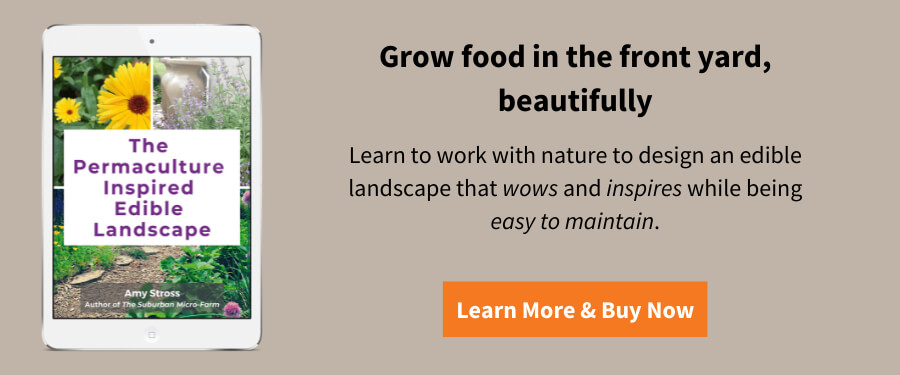The goal of a good design is to unify a space by providing blocks of color or texture that capture or direct the viewer’s eye. It is one of the most basic landscape design principles. Find out how to do it in your landscape, and attract beneficial insects, too!

This page may contain affiliate links. Please read my disclosure for more info.
Blocks of color unify a landscape, providing harmony. A viewer’s eye can take in a scene with blocks of color and make sense of what they are seeing.
Good design encourages a viewer to want to learn more.” ~Alexander Isley
In the above picture, purple salvia are the anchor of this early season front yard landscape that includes strawberries, currants, and a variety of herbs and leafy greens.
A month later, the salvia have petered out, and California poppies come alive to make a consistent backdrop to the front yard strawberry bed.

Strawberry bed with a backdrop of California poppies
A hodgepodge of plants and colors creates the opposite of unity—variety—and requires the eye to dart randomly about in search of meaning and rhythm. There is nothing wrong with variety as the theme of a garden. This type of garden could be called a “collector’s garden”, according to Rosalind Creasy, author of Edible Landscaping.
At the end of the day, however, I prefer the order and harmony that block plantings provide. As much as a block planting attracts the human eye, it also attracts beneficial insects.
A quick internet search will provide you with a list of plants that attract beneficial insects. The problem with a hodgepodge of plants from a list is that a beneficial insect searching for its favorite food or shelter may not find that single flowering plant you planted just for them.
But it could quickly spot a block planting of its favorite food.
Would you like to grow food in your front yard without sacrificing curb appeal? Check out my mini guide, The Permaculture Inspired Edible Landscape.

Swiss chard underplanted with sweet alyssum
In the above picture, the eye can make sense of this sidewalk border because of the consistent use of these two plants and colors. It tends to make the eye want to focus on this section of the garden, rather than wander around. The block of white flowers will attract a plethora of beneficial insects.
To read more about this combination, see my post Swiss Chard and Sweet Alyssum: Winning Edible Landscaping Combination.
I use block plantings of flowers to attract beneficial insects and to create unity in my edible landscape design.

Pathway framed by blocks of color
In the above picture, the eye doesn’t see that there are beets, broccoli, carrots, chives, collard greens, oregano, parsley, and tomatoes, because it is attracted to the blocks of color.
Unity as a principle of landscape design will allow you to create harmony and rhythm in your garden design while also ensuring that beneficial insects find the plantings you created for them.
What blocks of color do you use in your garden to create order and unity?
READ NEXT:






Jem says
Hi Amy, love your site and all the information, so useful. I’m looking for the map/design/sketch you made to plan your front garden – I saw it on here once and now can’t find it. I’m doing the PWG design course and designing my own garden. It would be great to see how you combined and spaced plants in your beds.
Thanks so much!
Amy says
Hi there, this article might be what you’re looking for: How Rainwater Harvesting Transformed My Front Yard Garden.
Fran Karol says
Hi what a helpful site this is for me as a beginner. I want to plant a small butterfly garden to assist me in my raising butterflies again this year project. Last year was my beginning and I started with a butterfly bush , a milkweed potted plant and alot of parsley potted plants. I bought a dill plant and the next morning I found that something nibbled most of it off I have a yarrow plant I hope the butterflies will like and I m starting some milkweeds from seed to plant. I would love to hear any suggestions you may have. Thanks, Fran